The Repurposing of the Antimalaria Drug, Primaquine, as a Photosensitizer to Inactivate Cryptococcal Cells
Abstract
1. Introduction
2. Materials and Methods
2.1. Materials
2.2. Cells, Cultivation and Standardization
2.3. UV Radiation
2.4. Preparation of Cells for Experimental Assays
2.5. Metabolic Activity Assay of Cryptococcal Cells
2.6. Effects of PDT with PQ on the Accumulation of Reactive Oxygen Species (ROS)
2.7. Effects of PDT with PQ on the Ultrastructure and Cell Membrane Integrity
2.8. Effects of PDT with PQ on the Phagocytic Efficiency of Murine Macrophages
2.9. Effects of PDT with PQ on the Metabolic Activity of Murine Macrophages
2.10. Statistical Analyses
3. Results
3.1. Cryptococcal Cells Were Susceptible to the Photodynamic Action of PQ
3.2. PDT with PQ Induces Accumulation of ROS
3.3. The Photolytic Products of PQ Alter the Cryptococcal Ultrastructure and Compromise Cell Membranes
3.4. PDT Improves the Phagocytic Efficiency of Macrophages
3.5. PDT Does Not Negatively Affect the Macrophages
4. Discussion
5. Conclusions
Author Contributions
Funding
Data Availability Statement
Acknowledgments
Conflicts of Interest
References
- Prescott, S.L.; Larcombe, D.L.; Logan, A.C.; West, C.; Burks, W.; Caraballo, L.; Levin, M.; Etten, E.V.; Horwitz, P.; Kozyrskyj, A.; et al. The Skin Microbiome: Impact of Modern Environments on Skin Ecology, Barrier Integrity and Systemic Immune Programming. World Allergy Organ. J. 2017, 10, 29. [Google Scholar] [CrossRef]
- Lehtimäki, J.; Karkman, A.; Laatikainen, T.; Paalanen, L.; Von Hertzen, L.; Haahtela, T.; Hanski, I.; Ruokolainen, L. Patterns in the Skin Microbiota Differ in Children and Teenagers Between Rural and Urban Environments. Sci. Rep. 2017, 7, 45651. [Google Scholar] [CrossRef]
- Nestle, F.O.; Di Meglio, P.; Qin, J.Z.; Nickoloff, B.J. Skin Immune Sentinels in Health and Disease. Nat. Rev. Immunol. 2009, 9, 679–691. [Google Scholar] [CrossRef]
- Neuville, S.; Dromer, F.; Morin, O.; Dupont, B.; Ronin, O.; Lortholary, O.; French Cryptococcosis Study Group. Primary Cutaneous Cryptococcosis: A Distinct Clinical Entity. Clin. Infect. Dis. 2003, 36, 337–347. [Google Scholar] [CrossRef]
- Chakradeo, K.; Paul Chia, Y.Y.; Liu, C.; Mudge, D.W.; De Silva, J. Disseminated Cryptococcosis Presenting Initially as Lower Limb Cellulitis in a Renal Transplant Recipient-A Case Report. BMC Nephrol. 2018, 19, 18. [Google Scholar] [CrossRef] [PubMed]
- Casadevall, A. Cryptococci at the Brain Gate: Break and Enter or Use a Trojan Horse? J. Clin. Investig. 2010, 120, 1389–1392. [Google Scholar] [CrossRef]
- Voelz, K.; May, R.C. Cryptococcal Interactions with the Host Immune System. Eukaryot. Cell 2010, 9, 835–846. [Google Scholar] [CrossRef] [PubMed]
- Rajasingham, R.; Smith, R.M.; Park, B.J.; Jarvis, J.N.; Govender, N.P.; Chiller, T.M.; Denning, D.W.; Loyse, A.; Boulware, D.R. Global Burden of Disease of HIV-Associated Cryptococcal Meningitis: An Updated Analysis. Lancet Infect. Dis. 2017, 17, 873–881. [Google Scholar] [CrossRef]
- Cowen, L.E. The Evolution of Fungal Drug Resistance: Modulating the Trajectory from Genotype to Phenotype. Nat. Rev. Microbiol. 2008, 6, 187–198. [Google Scholar] [CrossRef] [PubMed]
- Govender, N.P.; Roy, M.; Mendes, J.F.; Zulu, T.G.; Chiller, T.M.; Karstaedt, A.S. Evaluation of Screening and Treatment of Cryptococcal Antigenaemia among HIV-Infected Persons in Soweto, South Africa. HIV Med. 2015, 16, 468–476. [Google Scholar] [CrossRef] [PubMed]
- Ghannoum, M.A.; Rice, L.B. Antifungal Agents: Mode of Action, Mechanisms of Resistance and Correlation of These Mechanisms with Bacterial Resistance. Clin. Microbiol. Rev. 1999, 12, 501–517. [Google Scholar] [CrossRef]
- Truong, M.; Monahan, L.G.; Carter, D.A.; Charles, I.G. Repurposing Drugs to Fast-Track Therapeutic Agents for the Treatment of Cryptococcosis. PeerJ 2018, 6, e4761. [Google Scholar] [CrossRef]
- Saag, M.S.; Graybill, R.J.; Larsen, R.A.; Pappas, P.G.; Perfect, J.R.; Powderly, W.G.; Sobel, J.D.; Dismukes, W.E. Practice Guidelines for the Management of Cryptococcal Disease. Clin. Infect. Dis. 2000, 30, 710–718. [Google Scholar] [CrossRef] [PubMed]
- Ho, J.; Fowler, P.; Heidari, A.; Johnson, R.H. Intrathecal Amphotericin B: A 60-Year Experience in Treating Coccidioidal Meningitis. Clin. Infect. Dis. 2016, 64, 519–524. [Google Scholar] [CrossRef]
- Cuddihy, G.; Wasan, E.K.; Di, Y.; Wasan, K.M. The Development of Oral Amphotericin B to Treat Systemic Fungal and Parasitic Infections: Has the Myth Been Finally Realised? Pharmaceutics 2019, 11, 99. [Google Scholar] [CrossRef] [PubMed]
- Bicanic, T.; Harrison, T.; Niepieklo, A.; Dyakopu, N.; Meintjes, G. Symptomatic Relapse of HIV-Associated Cryptococcal Meningitis after Initial Fluconazole Monotherapy: The Role of Fluconazole Resistance and Immune Reconstitution. Clin. Infect. Dis. 2006, 43, 1069–1073. [Google Scholar] [CrossRef]
- Jarvis, J.N.; Bicanic, T.; Loyse, A.; Namarika, D.; Jackson, A.; Nussbaum, J.C.; Longley, N.; Muzoora, C.; Phulusa, J.; Taseera, K.; et al. Determinants of Mortality in a Combined Cohort of 501 Patients With HIV-Associated Cryptococcal Meningitis: Implications for Improving Outcomes. Clin. Infect. Dis. 2014, 58, 736–745. [Google Scholar] [CrossRef]
- Smith, K.D.; Achan, B.; Hullsiek, K.H.; McDonald, T.R.; Okagaki, L.H.; Alhadab, A.A.; Akampurira, A.; Rhein, J.R.; Meya, D.B.; Boulware, D.R.; et al. Increased Antifungal Drug Resistance in Clinical Isolates of Cryptococcus neoformans in Uganda. Antimicrob. Agents Chemother. 2015, 59, 7197–7204. [Google Scholar] [CrossRef]
- Fuchs, B.B.; Tegos, G.P.; Hamblin, M.R.; Mylonakis, E. Susceptibility of Cryptococcus neoformans to Photodynamic Inactivation Is Associated with Cell Wall Integrity. Antimicrob. Agents Chemother. 2007, 51, 2929–2936. [Google Scholar] [CrossRef]
- Dai, T.; Fuchs, B.B.; Coleman, J.J.; Prates, R.A.; Astrakas, C.; St Denis, T.G.; Ribeiro, M.S.; Mylonakis, E.; Hamblin, M.R.; Tegos, G.P. Concepts and Principles of Photodynamic Therapy as an Alternative Antifungal Discovery Platform. Front. Microbiol. 2012, 3, 120. [Google Scholar] [CrossRef] [PubMed]
- Prates, R.A.; Fuchs, B.B.; Mizuno, K.; Naqvi, Q.; Kato, I.T.; Ribeiro, M.S.; Mylonakis, E.; Tegos, G.P.; Hamblin, M.R. Effect of Virulence Factors on the Photodynamic Inactivation of Cryptococcus neoformans. PLoS ONE 2013, 8, e54387. [Google Scholar] [CrossRef] [PubMed]
- Baltazar, L.M.; Ray, A.; Santos, D.A.; Cisalpino, P.S.; Friedman, A.J.; Nosanchuk, J.D. Antimicrobial Photodynamic Therapy: An Effective Alternative Approach to Control Fungal Infections. Front. Microbiol. 2015, 6, 202. [Google Scholar] [CrossRef] [PubMed]
- Saini, R.; Lee, N.V.; Liu, K.Y.P.; Poh, C.F. Prospects in the Application of Photodynamic Therapy in Oral Cancer and Premalignant Lesions. Cancers 2016, 8, 83. [Google Scholar] [CrossRef] [PubMed]
- Josefsen, L.B.; Boyle, R.W. Photodynamic Therapy and the Development of Metal-Based Photosensitisers. Met. Based Drugs 2008, 2008, 276109. [Google Scholar] [CrossRef]
- Hamblin, M.R.; Hasan, T. Photodynamic Therapy: A New Antimicrobial Approach to Infectious Disease? Photochem. Photobiol. Sci. 2004, 3, 436–450. [Google Scholar] [CrossRef]
- Wainwright, M.; Crossley, K.B. Methylene Blue-A therapeutic dye for all seasons? J. Chemother. 2002, 14, 431–443. [Google Scholar] [CrossRef]
- Slater, A.F.G. Chloroquine: Mechanism of Drug Action and Resistance in Plasmodium falciparum. Pharmacol. Ther. 1993, 57, 203–235. [Google Scholar] [CrossRef]
- Foley, M.; Tilley, L. Quinoline Antimalarials: Mechanisms of Action and Resistance and Prospects for New Agents. Pharmacol. Ther. 1998, 79, 55–87. [Google Scholar] [CrossRef]
- Percário, S.; Moreira, D.R.; Gomes, B.A.Q.; Ferreira, M.E.S.; Gonçalves, A.C.M.; Laurindo, P.S.O.C.; Vilhena, T.C.; Dolabela, M.F.; Green, M.D. Oxidative Stress in Malaria. Int. J. Mol. Sci. 2012, 13, 16346–16372. [Google Scholar] [CrossRef] [PubMed]
- Ha, Y.R.; Hwang, B.G.; Hong, Y.; Yang, H.W.; Lee, S.J. Effect of Farnesyltransferase Inhibitor R115777 on Mitochondria of Plasmodium falciparum. Korean J. Parasitol. 2015, 53, 421–430. [Google Scholar] [CrossRef] [PubMed]
- Toma, E. Clindamycin/Primaquine for Treatment of Pneumocystis carinii Pneumonia in AIDS. Eur. J. Clin. Microbiol. Infect. Dis. 1991, 10, 210–213. [Google Scholar] [CrossRef]
- Noskin, G.A.; Murphy, R.L.; Black, J.R.; Phair, J.P. Salvage Therapy with Clindamycin/Primaquine for Pneumocystis carinii Pneumonia. Clin. Infect. Dis. 1992, 14, 183–188. [Google Scholar] [CrossRef] [PubMed]
- Ogundeji, A.O.; Mjokane, N.; Folorunso, O.S.; Pohl, C.H.; Nyaga, M.M.; Sebolai, O.M. The Repurposing of Acetylsalicylic Acid as a Photosensitiser to Inactivate the Growth of Cryptococcal Cells. Pharmaceuticals 2021, 14, 404. [Google Scholar] [CrossRef]
- Harrington, B.; Valigosky, M. Monitoring Ultraviolet Lamps in Biological Safety Cabinets with Cultures of Standard Bacterial Strains on TSA Blood Agar. Lab. Med. 2007, 38, 165–168. [Google Scholar] [CrossRef]
- Swart, C.W.; Swart, H.C.; Coetsee, E.; Pohl, C.H.; van Wyk, P.W.J.; Kock, J.L.F. 3-D Architecture and Elemental Composition of Fluconazole Treated Yeast Asci. Sci. Res. Essays 2010, 5, 3411–3417. [Google Scholar]
- Hussain, H.; Raj, L.S.; Ahmad, S.; Abd. Razak, M.F.; Wan Mohamud, W.N.; Bakar, J.; Ghazali, H.M. Determination of Cell Viability Using Acridine Orange/Propidium Iodide Dual-Spectrofluorometry Assay. Cogent Food Agric. 2019, 5, 1582398. [Google Scholar] [CrossRef]
- Levitz, S.M.; Harrison, T.S.; Tabuni, A.; Liu, X. Chloroquine Induces Human Mononuclear Phagocytes to Inhibit and Kill Cryptococcus neoformans by a Mechanism Independent of Iron Deprivation. J. Clin. Investig. 1997, 100, 1640–1646. [Google Scholar] [CrossRef]
- Shen, Q.; Beucler, M.J.; Ray, S.C.; Rappleye, C.A. Macrophage Activation by IFN-γ Triggers Restriction of Phagosomal Copper from Intracellular Pathogens. PLoS Pathog. 2018, 14, e1007444. [Google Scholar] [CrossRef]
- Weissgerber, T.L.; Milic, N.M.; Winham, S.J.; Garovic, V.D. Beyond Bar and Line Graphs: Time for a New Data Presentation Paradigm. PLoS Biol. 2015, 13, e1002128. [Google Scholar] [CrossRef] [PubMed]
- Kristensen, S.; Edge, R.; Tønnesen, H.H.; Bisby, R.H.; Navaratnam, S. Photoreactivity of Biologically Active Compounds. XIX: Excited States and Free Radicals from the Antimalarial Drug Primaquine. J. Photochem. Photobiol. B. 2009, 94, 147–157. [Google Scholar] [CrossRef] [PubMed][Green Version]
- Giroldo, L.M.; Felipe, M.P.; de Oliveira, M.A.; Munin, E.; Alves, L.P.; Costa, M.S. Photodynamic Antimicrobial Chemotherapy (PACT) with Methylene Blue Increases Membrane Permeability in Candida albicans. Lasers Med. Sci. 2009, 24, 109–112. [Google Scholar] [CrossRef] [PubMed]
- Kharkwal, G.B.; Sharma, S.K.; Huang, Y.Y.; Dai, T.; Hamblin, M.R. Photodynamic Therapy for Infections: Clinical Applications. Lasers Surg. Med. 2011, 43, 755–767. [Google Scholar] [CrossRef] [PubMed]
- Kim, M.M.; Darafsheh, A.; Ahmad, M.; Finlay, J.C.; Zhu, T.C. PDT Dose Dosimeter for Pleural Photodynamic Therapy. Proc. SPIE Int. Soc. Opt. Eng. 2016, 9694, 96940Y. [Google Scholar] [CrossRef] [PubMed][Green Version]
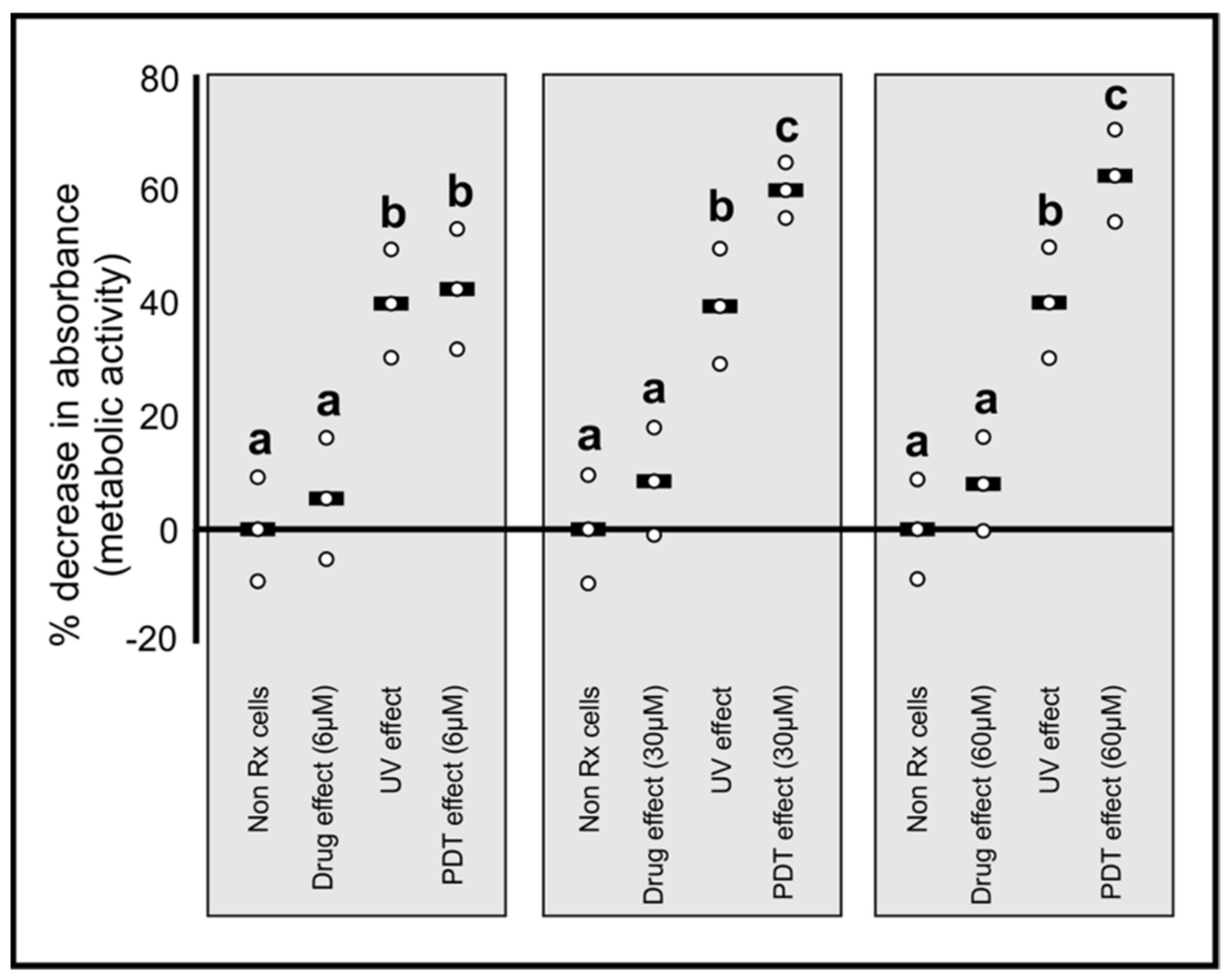
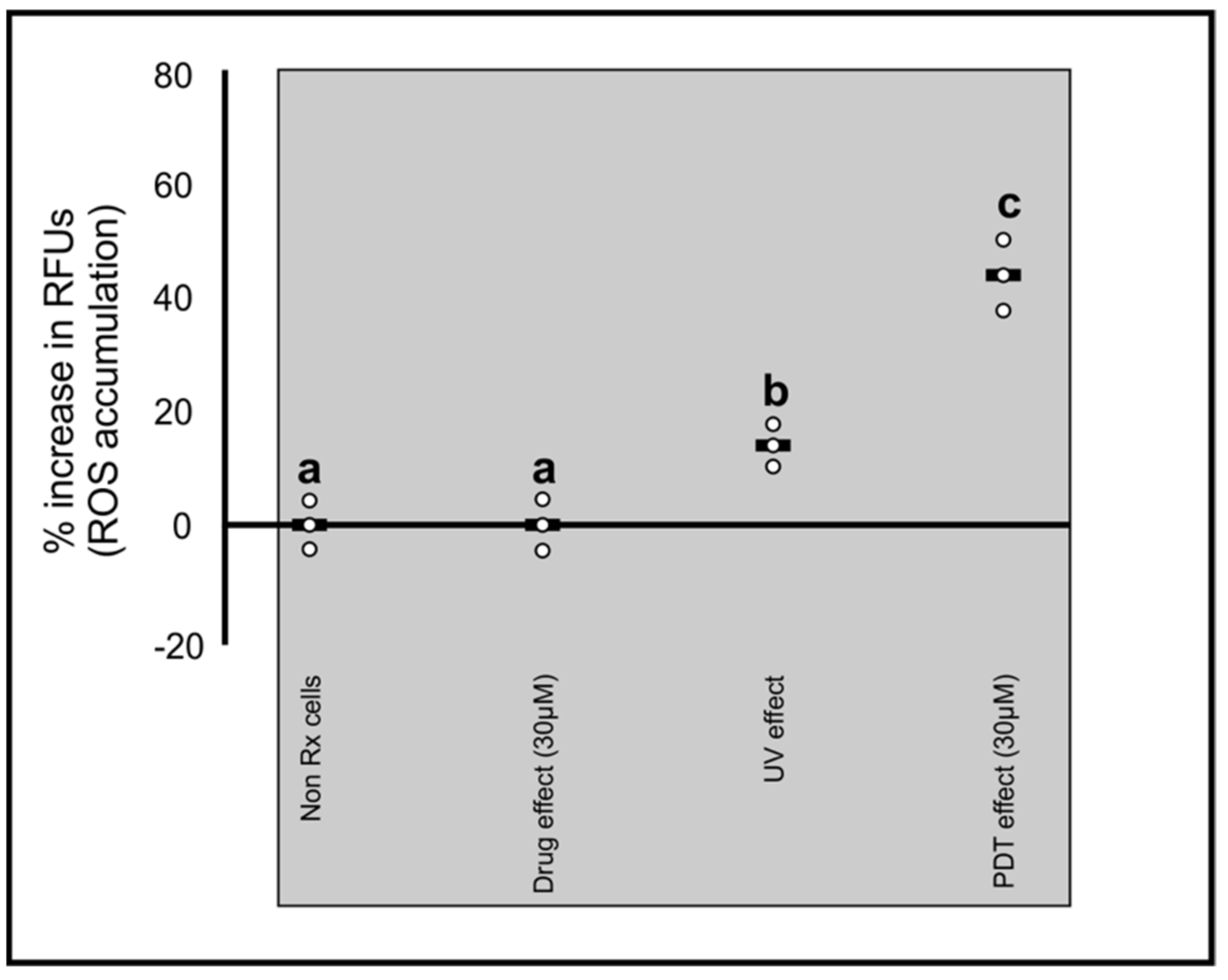

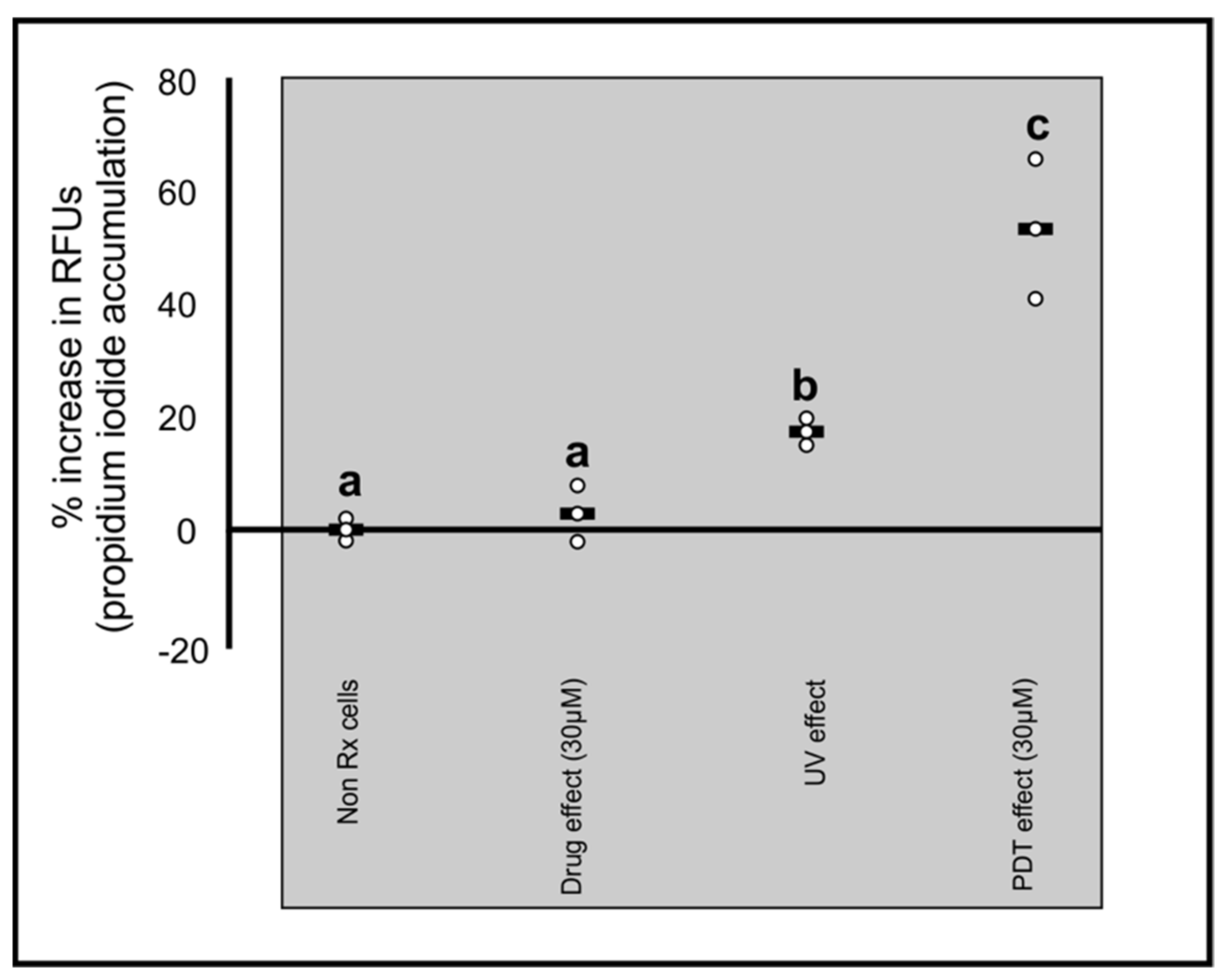
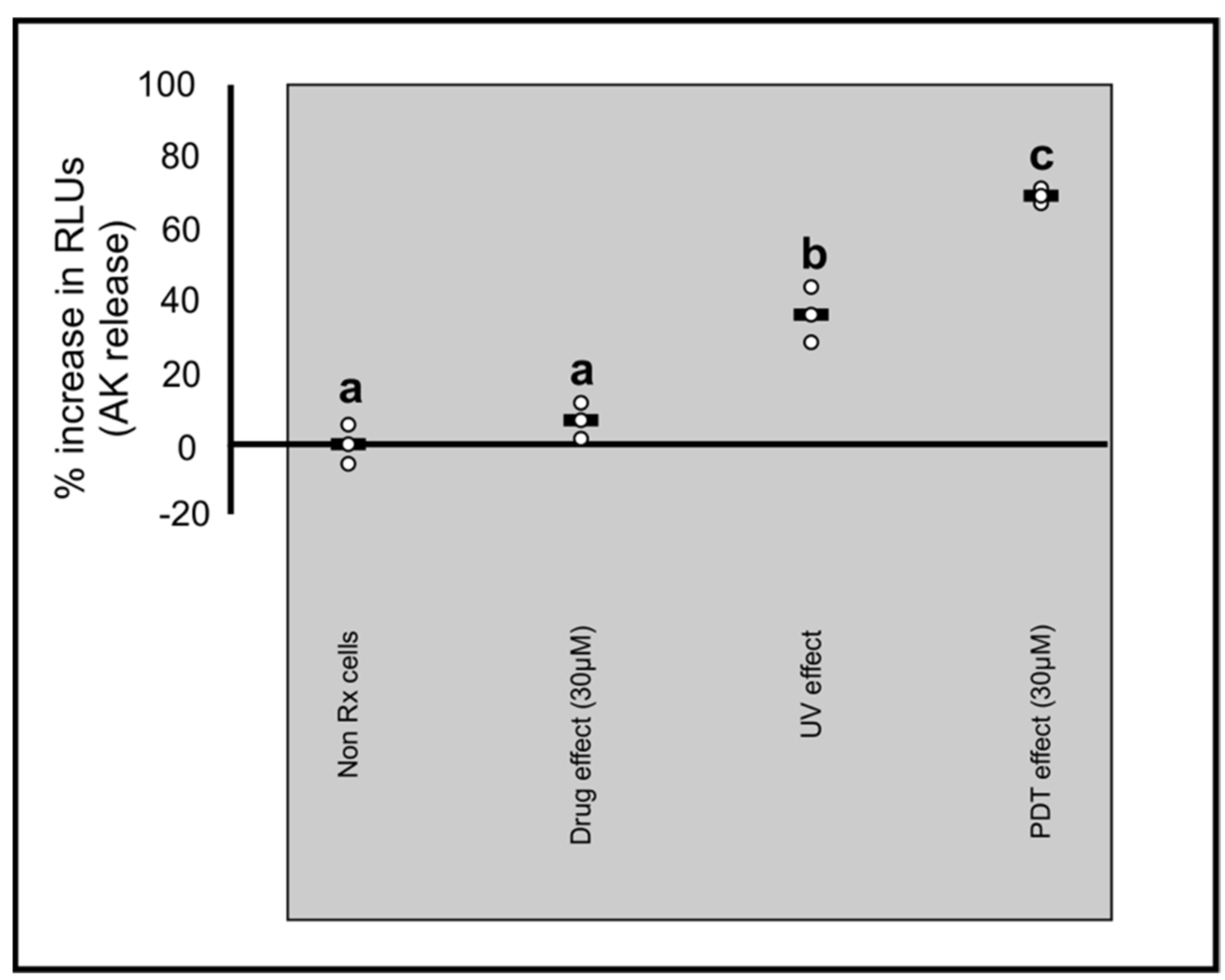
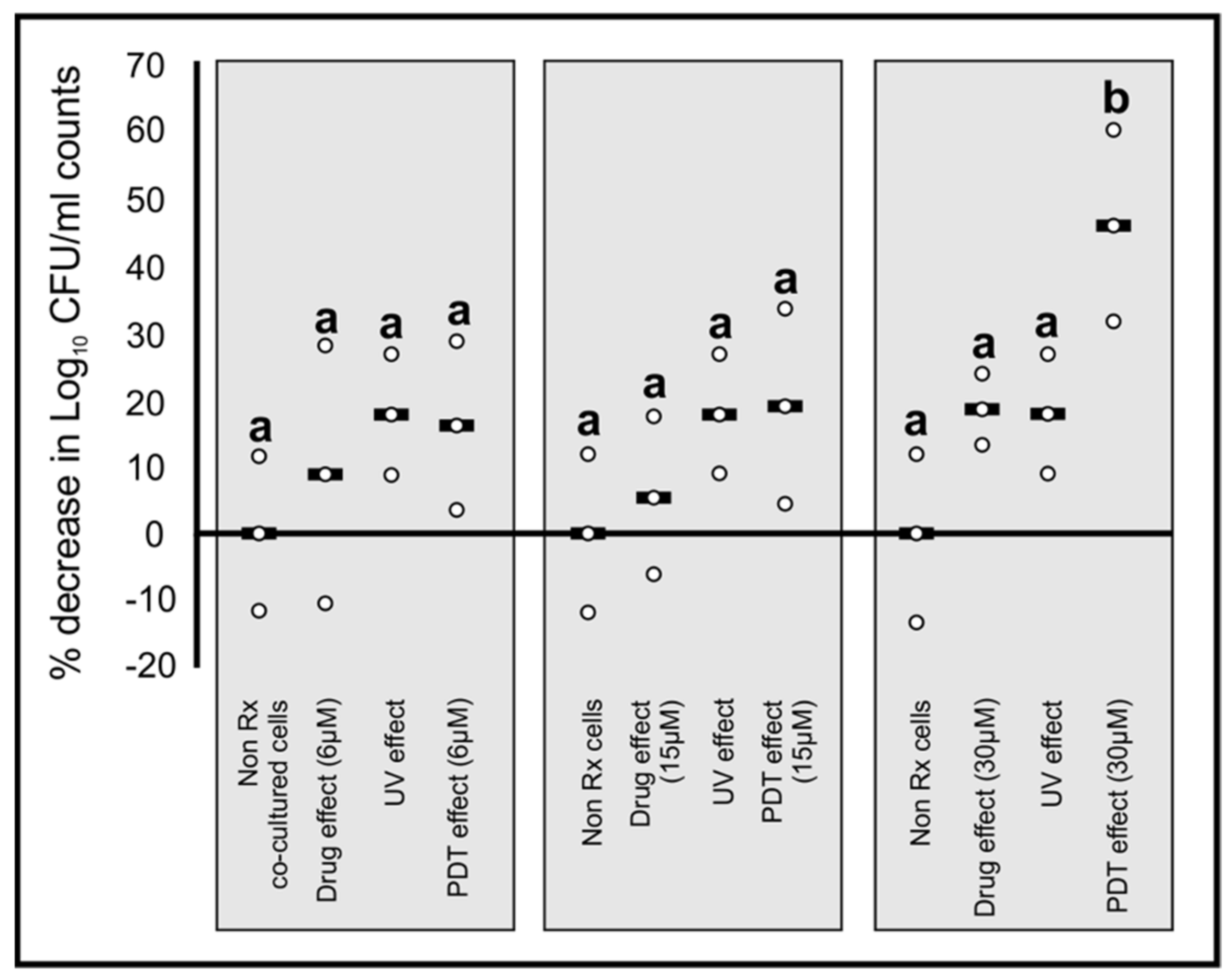
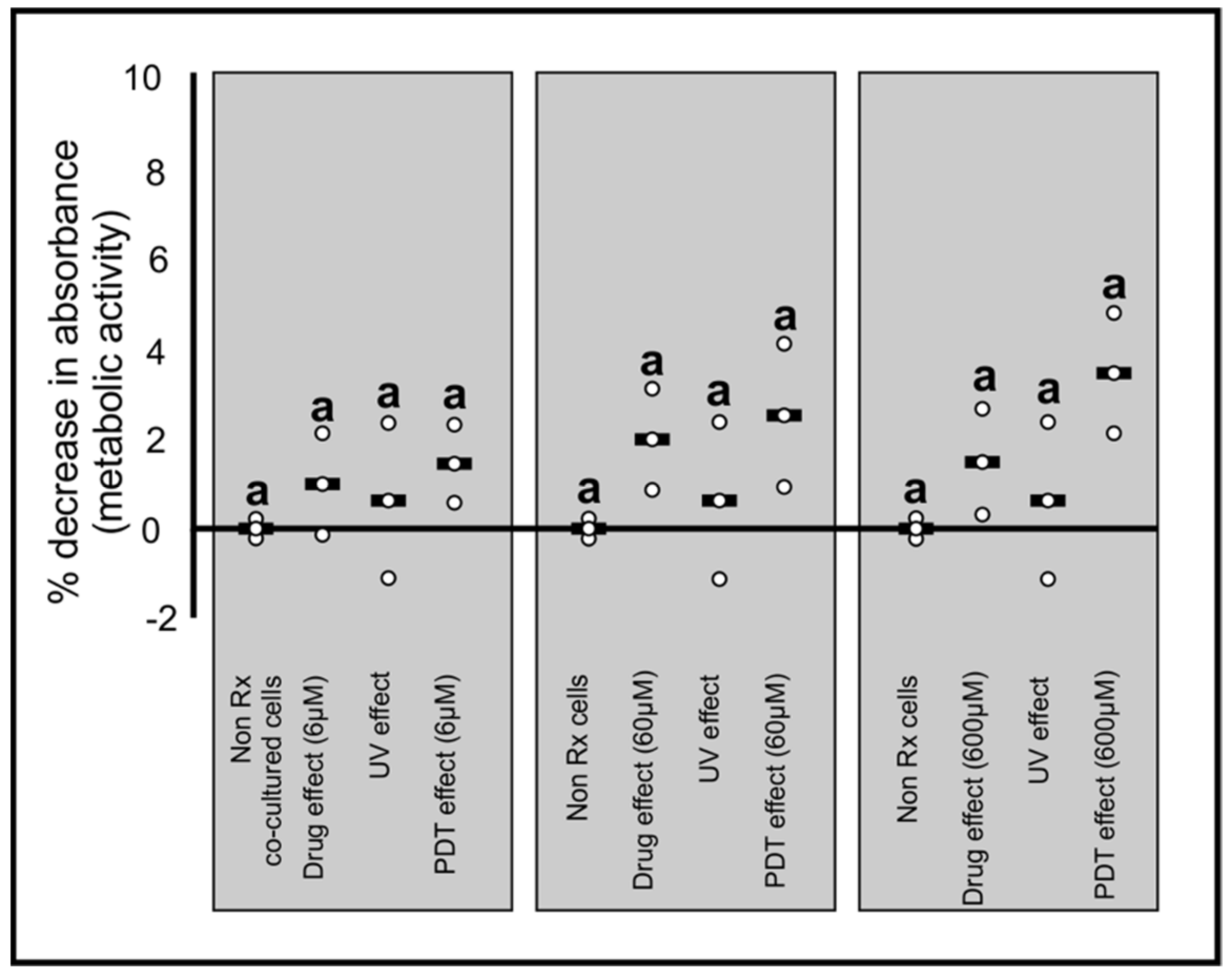
Publisher’s Note: MDPI stays neutral with regard to jurisdictional claims in published maps and institutional affiliations. |
© 2021 by the authors. Licensee MDPI, Basel, Switzerland. This article is an open access article distributed under the terms and conditions of the Creative Commons Attribution (CC BY) license (https://creativecommons.org/licenses/by/4.0/).
Share and Cite
Madu, U.L.; Ogundeji, A.O.; Folorunso, O.S.; Albertyn, J.; Pohl, C.H.; Sebolai, O.M. The Repurposing of the Antimalaria Drug, Primaquine, as a Photosensitizer to Inactivate Cryptococcal Cells. Photochem 2021, 1, 275-286. https://doi.org/10.3390/photochem1020017
Madu UL, Ogundeji AO, Folorunso OS, Albertyn J, Pohl CH, Sebolai OM. The Repurposing of the Antimalaria Drug, Primaquine, as a Photosensitizer to Inactivate Cryptococcal Cells. Photochem. 2021; 1(2):275-286. https://doi.org/10.3390/photochem1020017
Chicago/Turabian StyleMadu, Uju L., Adepemi O. Ogundeji, Olufemi S. Folorunso, Jacobus Albertyn, Carolina H. Pohl, and Olihile M. Sebolai. 2021. "The Repurposing of the Antimalaria Drug, Primaquine, as a Photosensitizer to Inactivate Cryptococcal Cells" Photochem 1, no. 2: 275-286. https://doi.org/10.3390/photochem1020017
APA StyleMadu, U. L., Ogundeji, A. O., Folorunso, O. S., Albertyn, J., Pohl, C. H., & Sebolai, O. M. (2021). The Repurposing of the Antimalaria Drug, Primaquine, as a Photosensitizer to Inactivate Cryptococcal Cells. Photochem, 1(2), 275-286. https://doi.org/10.3390/photochem1020017





